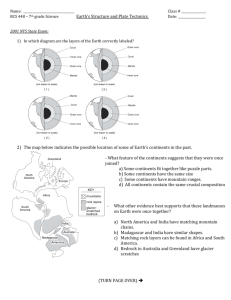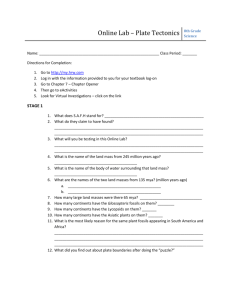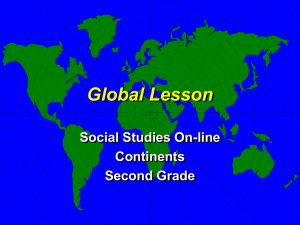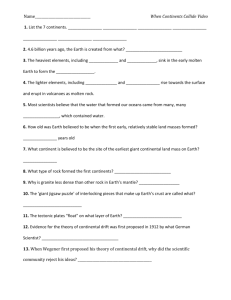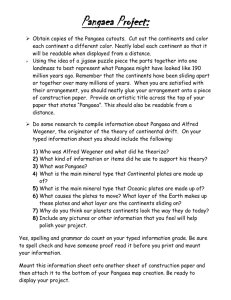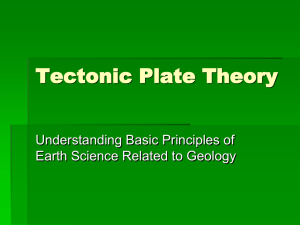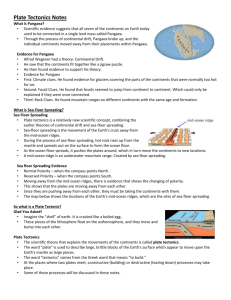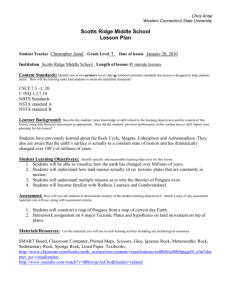File
advertisement
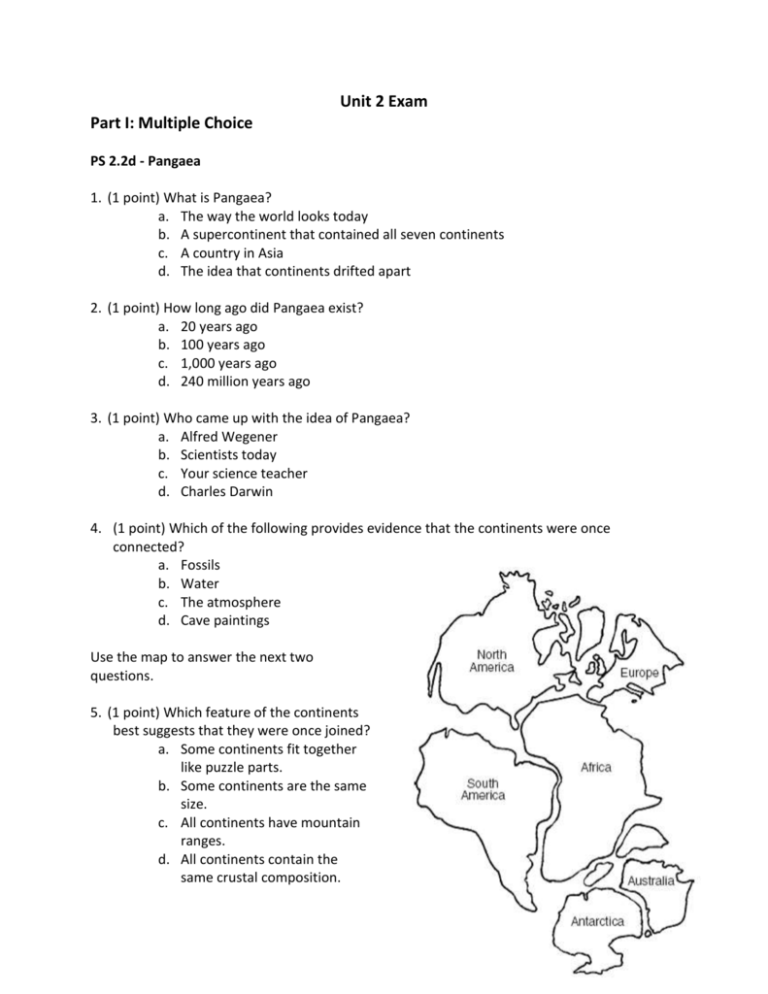
Unit 2 Exam Part I: Multiple Choice PS 2.2d - Pangaea 1. (1 point) What is Pangaea? a. The way the world looks today b. A supercontinent that contained all seven continents c. A country in Asia d. The idea that continents drifted apart 2. (1 point) How long ago did Pangaea exist? a. 20 years ago b. 100 years ago c. 1,000 years ago d. 240 million years ago 3. (1 point) Who came up with the idea of Pangaea? a. Alfred Wegener b. Scientists today c. Your science teacher d. Charles Darwin 4. (1 point) Which of the following provides evidence that the continents were once connected? a. Fossils b. Water c. The atmosphere d. Cave paintings Use the map to answer the next two questions. 5. (1 point) Which feature of the continents best suggests that they were once joined? a. Some continents fit together like puzzle parts. b. Some continents are the same size. c. All continents have mountain ranges. d. All continents contain the same crustal composition. 6. (1 point) Part of the east coast of South America and the west coast of Africa have matching fossils within the same series of rock layers. This provides evidence that these two continents were once a. separated by a much larger ocean b. joined together as one piece of land c. located near the North Pole d. in a different hemisphere Use the map below to answer the next two questions. It indicates the possible location of some of Earth’s continents in the past. 7. (1 point) Which evidence best supports the idea that the landmasses on Earth were once in these positions? a. North America and India have matching mountain chains. b. Madagascar and India have similar shapes. c. Matching rock layers can be found in Africa and South America. d. Bedrock in Greenland and Australia have glacier scratches. 8. (1 point) According to evidence from mountain ranges, which two landmasses were probably once connected? a. Greenland and Africa c. South America and Africa b. Greenland and Europe d. Europe and Africa PS 2.2b - Layers of the Earth & Convection (1 point each) Directions: For each of the layers of the earth below, write down the letter of the statement that best describes it. One answer has two answer choices. 9. _____ CRUST a. Uses convection currents to move around molten rock. 10. _____ MANTLE b. Hottest layer of the earth 11. _____ CORE c. Thin layer of rock that is under oceans and continents. 12. (1 point) In which diagram are the layers of the earth correctly labeled? 13. (1 point) Using the diagram above, which type of crust is thicker? ______________________________________________________________________________ ______________________________________________________________________________ 14. (1 point) How is the temperature of the earth’s crust different from the temperature of the inside of the earth? Which is hotter? Explain why using the picture. ______________________________________________________________________________ ______________________________________________________________________________ 15. (1 point) Many scientists believe that plates move because of convection currents in Earth’s a. crust b. mantle c. outer core d. inner core 16. (1 point) Look at the drawing of earth’s interior. Arrows in the drawing show which of the following? a. earthquakes b. continents c. convection currents d. continental drift PS 2.2e - Theory of Plate Tectonics & Plate Boundaries 17. (1 point) The map shows some geologic features located near the west coast of the United States. The arrows on either side of the fault represent a. volcanic eruptions b. rock formations c. the movement of air masses d. the relative movement of tectonic plates (transform boundary) 18. (1 point) Movement of earth’s crust along plate boundaries produces a. Thunderstorms b. Tornados c. Hurricanes d. Earthquakes 19. (1 point) The bold line on the map shows the San Andreas fault. The San Andreas fault is the result of a. people b. a large glacier c. weather d. plate movement 20. (1 point) Identify one geologic event that often occurs near the type of plate boundary in the diagram below. (1 point each) Each of the statements below describes a type of plate boundary. Read over them. Choose the answer choice that matches ALL of the statements with the correct plate boundary. I. The movement of plates past one another (sliding motion) can cause earthquakes II. Magma rises to the Earth’s surface from plates that move apart and forms valleys III. When these plates move together, they often form mountain ranges 21. _____ CONVERGENT BOUNDARY 22. _____ DIVERGENT BOUNDARY 23. _____ TRANSFORM BOUNDARY 24. (1 point) Place an X on the map below to indicate the location at 20S 60 W. Volcanoes and Rocks 25. A volcano erupts violently sending ash in the air every week. This volcano is a. Active b. Dormant c. Extinct 26. Scientists say that Mt. St. Helen’s volcano is _________ because it never erupts and will not erupt again. a. Active b. Dormant c. Extinct Name:______________________ _________________________________ Class:___________ Unit 2 Exam PS 2.2d 1. ______________ 2. ______________ 3. ______________ 4. ______________ 5. ______________ 6. ______________ 18. ______________ 19. ______________ 20. _________________________ 21. ______________ 22. ______________ 23. ______________ 24. 7. ______________ 8. ______________ PS 2.2b 9. ______________ 10. ______________ 11. ______________ 12. ______________ 13. _________________________________ _________________________________ _________________________________ 14. _________________________________ _________________________________ _________________________________ 15. ______________ 16. ______________ PS 2.2e 17. ______________ Volcanoes 25. _____________ 26. ______________

